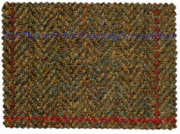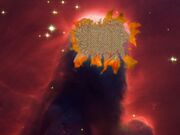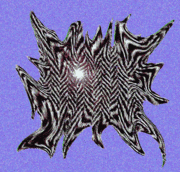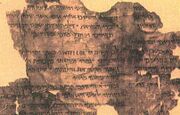Tweed
Tweed (10,000,000,000 BC +1 - Present) Is a fabric like substance famous for its cloth like properties. Traditionally woven with hands, it can also be made of wool. Tweed is a social outcast in the world of fashion but has had psychiatric therapy since it's teenage years and is now - like all good fitting clothes - well adjusted.
A brief History of tweed.[edit]
Many participants of the ‘mankind’ movement would be familiar with tweed as a type of woven cloth worn by esteemious folk who strive to single-handedly rescue humanity from sartorial insignificance. Huzzah! But tweed, has not always existed in this form alone, and has had a long and ‘checked’ history, which until now has been only known to a select few. For the benefit of a tweed wearing public, the history of this noble linen is presented here, in English, for the benefit of a tweed wearing public.
Early Origins.[edit]
According to current scientific theory, Tweed appeared in its earliest from just a few seconds after the Big Bang. Supercharged particles of light-matter were created and as the rapidly expanding universe began to cool, this light-matter, now understood to be a crude type of tweed , began to form and join together to create strange subatomic shapes. These minuscule shapes and subsequent forming patterns resemble what we now know as houndstooth and herringbone.
Scattered across the universe, some of these tiny particles occasionally are identified by various space agencies and recorded as ‘errors’ in detecting equipment. Other recorded instances of this early tweed can be seen where, under the strength of gravitational attraction, clusters of billions of ‘tweed stars’ form magnificent nebulae.
Millions of years passed, and slowly our own solar system came into being. The Earth cooled and under geothermal pressure and tectonic plate shifts, land masses began to form. The atmosphere also cooled, and the seas were born. Over several thousands of millions of years, the earth went around the sun 3 billion times. The first organic life forms came into being, single celled organisms formed, and to cut a long story short, the next day the dinosaurs ruled the earth. Predictably, the world was governed under a dinocray. Surviving records show that the dinocracy was a successful form of government with a high standard of living enjoyed by many species of ‘dinosaur’. And thus, we can conclude, Life for them was good. Art galleries and schools alike had adequate funding, and before long these 'terrible lizards' which were once feared by lower life forms, plants for instance, became a point of ridicule as the dinosaurs began to live lives of excess and indulgence.
All this revelry and hedonistic behavior came to an abrupt end sometime during the facetious period, when the Earth was hit by a huge meteorite. The dinosaurs became extinct in what evolutionists and deities alike - would call a very short time. Theories abound linking this asteroid impact to the demise of the dinosaurs, and only since excavations of the said meteor site have shown how this mass extinction took place.
Unlike any other seen on earth, the asteroid contained an foreign organism, an alien parasite, that would change the course of biological development on Earth forever. (See case study 3-2=1)
Dark ages[edit]
There is very little documented of tweed during this period in time, partly due to poor literacy skills, and partly due development of information technology being considered by much of the world public, as ‘being in the dark ages’.
It can be noted, however, that the Bayeux Tapestry, depicting the scenes in 1066, is stitched into a large piece of monocoloured hand-woven fabric. For the sake of association, we’ll call this fabric tweed.
Middle ages[edit]
The Middlle Ages are significant as The mastery of hand woven fabrics improved considerably. Populations in northern and western Europe use wool based tweed style fabrics almost exclusively to other fabrics. Sacrificed bodies found in the bogs of Norway, Ireland and Sweden are almost always found dressed in clothing that bears an incredible resemblance to modern Tweed. Cultural historians theorize that sacrifices were killed to appease the gods and through such dramatic act, the gods would provide ideal weather conditions for bountiful crops and liberate the community from disease and hardship. The fact that many of these sacrifices are found today in the bogs wearing tweed, whilst populations in these areas survive today, can lead us to the conclusion that such sacrifices were ultimately successful.
Renaissance.[edit]
The cultural tour de force that was the renaissance could have not happened without tweed. Whilst still being an important clothing material of the day, the thriving art scene that we associate with Florence and the Medici family would have been far less significant without tweed as an backbone of the industry. Leonardo Da Vinci, for instance, painted the Mona Lisa on a piece of herringbone tweed made by Donegal fisherboys. Michaelangelo’s scaffolding that enabled him to paint the lofty ceiling of the Sistine chapel was, too, made entirely of tweed.
1600’s to 1900’s[edit]
This period is probably the most unfortunate period for tweed, as other fabrics rose in popularity. Over-use of the word period during this period also caused reader distress, but periodically, and over time, things settled down somewhat. Silk and cotton inadvertently became more fashionable amongst the higher classes, rendering tweed to be associated as a ‘dressage du peasant’. Through this calamitous phase in history, though, the Tweed Appreciation Society[1] was born. However, during the 19th Century, locals of the north-eastern corner of the Australian state of New South Wales became obsessed with tweed after someone found a then-rare tweed garment in an opp shop. People began to replicate the garment until it was worn all throughout the community, making it at the time the world's only tweed-wearing municipality. This would later lead to the community becoming known as the Tweed Shire in 1947.
Modern Age.[edit]
Tweed exists only as a novelty item in the modern man’s wardrobe, and should only be worn by those who really mean it. The character ‘Langdon’ in Dan Brown’s ‘Da’ Da Vinci Code wore tweed, but this is disputed by Tom Hank’s character in the film of the same name.
Tweed is in constant sartorial competition with Gore Tex a fabric that has also fallen from favour since the 1992 U.S. presidential erection.
Führer Reading[edit]
There are two case studies in this section for students who want further reading.
Case Study. Tweedius Interuptus[edit]
Recent samples taken from a meteorite show a fossilized multiple celled organism, with long flagellates tails at it’s least proximal end. The organism, which has been classified as Tweedius Interruptus, contains no DNA, the building plan for all organisms on earth. What it does contain in its nucleus is a small protein string, that is biologically ‘sticky’ when brought in contact with DNA of another living creature. The protein string then attaches itself to the host DNA, which then, it is theorized, is replicated in it’s new modified state when the host cell multiplies.
It is assumed that once, latched onto it’s host, Tweeds Interruptus receives fluids, nutrition and a decent public school education. Consultant physicists assume TI stayed warm during it hurtling through space on the meteorite through the insulating warmth of it’s cell membrane, when viewed under a microscope looks very similar to a Donegal weave. Almost every mammal has some sort of hairy covering, of which the precursor, was the tweed parasite. The best example of this evolutionary development is the sheep.
The theory that holds in the corridors of power that is part of the Tweed Appreciation Society’s Clubhouse is that the Tweed based parasite ‘T.I.’ repopulated itself on the outer skin of many dinosaurs and as they reproduced, they found it difficult , biologically, to maintain body temperature. Being cold blooded creatures, and being encumbered with this new wool like covering, they simply over heated and died out. The only animals to survive were, in fact, the world’s primitive mammal population, who through their size escaped this bio-thermostat problem.
The parasite was eventually to be to the benefit of the mammal, as it provided insulation for the ensuing ice age. The humble sheep Ovine interventionus is probably the best creature to illustrate how this alien organism has so become much of the biological landscape.
Case study: Tweed in the bible.[edit]
There are many references to tweed in holy texts, namely the Christian bible. Through various translations and over the passage of time much of these citations have been lost or corrupted from their base texts. For instance, where we read in the new testament, (King James Version, Jesus Clothes the Leper, Luke 18,44) And Jesus saw the leper, and he felt the wind, and he said to the leper, are you cold leper?. And the Leper replied yes, Jesus handed the leper a blanket in which to wrap himself. And the leper was warm. Newly uncovered passages in the Dead sea Scrolls indicate that it wasn’t in fact a blanket that Jesus gives the leper, but in fact a three piece worsted tweed suit, made to measure by Atkins and Brimms, Savile Row. It is now understood that was in fact Jesus’ own suit, which sheds light on why the Soldiers cast lots on Jesus clothes shortly after his crucifixion. He was obviously a man of style and panache, as well as being the savior of mankind.
Sources.[edit]
- Ketchup 3rd May 1987
- Cat-sup 14th February 1675, page 23
- Kitten Huffing Relish 35th Donkey, elected president.





